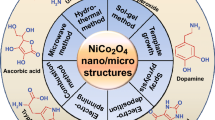Abstract
The preparation, electrochemical and catalytic behaviour of glassy carbon electrodes modified by anthra-9,10-quinone, its amino derivatives and dyes were investigated. The stability of the modified electrodes was studied by cyclic voltammetry in acidic and neutral media. The electrocatalytic ability of the modified electrodes for the reduction of dioxygen to hydrogen peroxide was examined by cyclic voltammetry, chronoamperometry and chronocoulometry techniques. The influence of pH on the electrochemical and catalytic behaviour was studied and pH 5.0–8.0 was chosen as the optimum working pH by comparing the shift in oxygen reduction potential. The anthraquinone-adsorbed glassy carbon electrodes possess excellent electrocatalytic abilities for dioxygen reduction with overpotential ranging from 280 to 560 mV lower than that at a plain glassy carbon electrode. Hydrodynamic voltammetric studies were performed to determine the heterogeneous rate constants for the reduction of O2 at the surface of the modified electrodes, mass specific activity of the anthraquinones used and the apparent diffusion coefficient of O2 in buffered aqueous O2-saturated solutions. Studies showed the involvement of two electrons in dioxygen reduction.








Similar content being viewed by others

References
Salimi A, Ghadermazi M (2001) Anal Sci 17:1165
Williams MC (ed) (2000) Fuel cell handbook, 5th edn. US Department of Energy, Washington, pp 1–37
Lai ME, Bergel A (2000) J Electroanal Chem 494:30
Paulus UA, Schmidt TJ, Gasteiger HA, Behm RJ (2001) J Electroanal Chem 495:134
Ohde H, Maeda K, Yoshida Y, Kihara S (2000) J Electroanal Chem 483:108
Shi C, Anson FC (2000) J Electroanal Chem 484:144
Mao L, Zhang D, Sotomura T, Nakatsu K, Koshiba N, Ohsaka T (2003) Electrochim Acta 48:1015
Peressini S, Tavagnacco C, Costa G, Amatore C (2002) J Electroanal Chem 532:295
Vukmirovic MB, Vasiljevic N, Dimitrov N, Sieradzki K (2003) J Electrochem Soc 150 (1):B10–B15
Gonzalez-Cruz R, Solorza-Feria O (2003) J Solid State Electrochem 7:289
Ramirez G, Trollund E, Isaacs M, Armijo F, Zagal J, Costamagna J, Aguirre MJ (2002) Electroanalysis 14:540
Lin AS, Huang JC (2003) J Electroanal Chem 541:147
Chithra R, Renuka R (2003) J Appl Electrochem 33:443
Zhang Y, Asahina S, Yoshihara S, Shirakashi T (2003) Electrochim Acta 48:741
Manisankar P, Mercy Pushpalatha A, Vasanthkumar S, Gomathi A, Viswanathan S (2004) J Electroanal Chem 571:43
Golabi SM, Raoof JB (1996) J Electroanal Chem 416:75
Sarapuu A, Vaik K, Schiffrin DJ, Tammeveski K (2003) J Electroanal Chem 541:23
Tammeveski K, Kontturi K, Nichols RJ, Potter RJ, Schiffrin DJ (2001) J Electroanal Chem 515:101
Salimi A, Mousavi MF, Sharghi H, Shamsipur M (1999) Bull Chem Soc Jpn 72:2121
Salimi A, Eshghi H, Sharghi H, Golabi SM, Shamsipur M (1999) Electroanalysis 11:114
Zon A, Palys M, Stojek Z, Sulowska H, Ossowski T (2003) Electroanalysis 15:579
Hu SS, Xu CL, Wang GP, Cui DF (2001) Talanta 54:115
Soriaga MP, Hubbard AT (1982) J Am Chem Soc 104:2735
He P, Crooks RM, Faulkner LR (1990) J Phys Chem 94:1135
Zhang J, Anson FC (1992) J Electroanal Chem 331:945
McDermott MT, Kneten K, McCreery RL (1992) J Phys Chem 96:3124
Mohan TM, Gomathi H, Rao GP (1990) Bull Electrochem 6:630
Gomathi H, Rao GP (1985) J Electroanal Chem 85:190
Shiu KK, Song F, Dai HP (1996) Electroanalysis 8:1160
Shamsipur M, Salimi A, Golabi SM, Sharghi H, Mousavi MF (2001) J Solid State Electrochem 5:68
Tsujimura S, Tatsumi H, Ogawa J, Shimizu S, Kano K, Ikeda T (2001) J Electroanal Chem 496:69
Brankovic SR, Wang JX, Adzic RR (2001) Electrochem Solid State Lett 4:A217
Author information
Authors and Affiliations
Corresponding author
Rights and permissions
About this article
Cite this article
Manisankar, P., Gomathi, A. & Velayutham, D. Oxygen reduction at the surface of glassy carbon electrodes modified with anthraquinone derivatives and dyes. J Solid State Electrochem 9, 601–608 (2005). https://doi.org/10.1007/s10008-004-0610-1
Received:
Revised:
Accepted:
Published:
Issue Date:
DOI: https://doi.org/10.1007/s10008-004-0610-1



